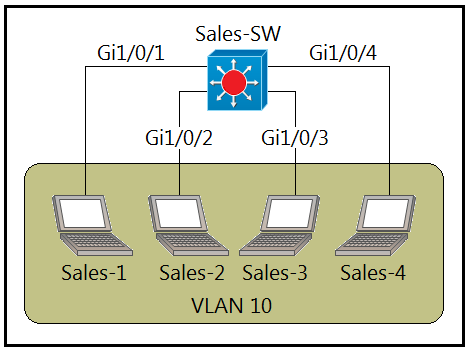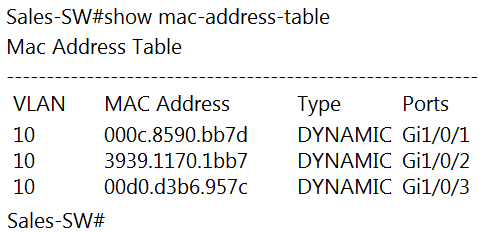
Refer to the exhibit. The entire contents or the MAC address table are shown. Sales-4 sends a data frame to Sales-1.

What does the switch do as it receives the frame from Sales-4?

Refer to the exhibit. The entire contents or the MAC address table are shown. Sales-4 sends a data frame to Sales-1.

What does the switch do as it receives the frame from Sales-4?
When the switch receives the frame from Sales-4, it first inserts Sales-4's source MAC address and its associated port (Gi1/0/4) into the MAC address table. Since the destination MAC address for Sales-1 is already known and present in the MAC address table, the switch will then forward the frame directly to the port where Sales-1 is connected (Gi1/0/1). This is the typical behavior of a switch when handling frames: learn the source MAC address and forward the frame based on the destination MAC address.
B IS CORRECT AS SWITCH KNOW DST , SO IT WILL REGISTER SRC IN CAM TABLE AND PASS THE DATA TO DST AS IT IS REGISTERED ALREADY IN CAM TABLE
B is right. Although the sentence "forward the frame to Sales-1" looks like a little strange.
Yes, B is the best answer. https://www.ciscopress.com/articles/article.asp?p=3089352&seqNum=6 D is incorrect because there is no reference to the frame MAC and port info being added to the table and Sales-4 is the originating machine.
Wouldn't it be D? Assuming Sales-4 never sent anything to Sales-1 (since there's no MAC address table entry from Sales-4 in the switch) it won't know Sales-1's MAC Address. Not knowing the MAC address, it'll use ARP and set broadcast FF:FF:FF:FF:FF:FF as the MAC Destination. When the Switch receives Sales-4s ARP request and see's the FF:FF:FF:FF:FF:FF in source MAC, it'll have no choice but to broadcast it to all ports except from where it came from. The only way it could be B is if Sale-4 already had Sales-1's MAC address cached in it's arp table. Am I over thinking this?
The switch already knows Sale-1s address and the switch is forwarding the traffic ao it doesn't matter if Sale-4 knows where the traffic is going or not as the question is asking what the switch will do.
Exactly. The switch is already aware of the address to forward the frame. What it does is to recognize the new device Mac Sales-4 and adds it Mac to its CAM and forwards the frame to the existing Mac sales-1
Sales 4 is a PC..how would it have MAC address tables?
B is correct!
D is incorrect, it says it will flood to all ports except to Sales-1, the one you're trying to reach. Switches flood to all ports except the one the frame was received (in this case Sales-4).
it can not be answer D because switch knows the destination MAC.
B indeed
B is correct
I think answer should be D. Answer B says that adds the MAC information to the table when it’s already in. In the exhibit you can see that laptop 4 is not in the table, so the switch needs to find where is it by flooding all ports except the one the petition came from. D
When Sales-4 sends the frame to Sales-1, the Sales-SW switch will receive the frame first and add the MAC address of Sales-4 and Gi1/0/4 to the CAM table. The switch will already have Sales-1's MAC address and port and forward the frame as requested.
>>> "In the exhibit you can see that laptop 4 is not in the table, so the switch needs to find where is it by flooding all ports except the one the petition came from". This would be the case if Sales-1 were trying to frames to Sales-4, but it is the other way around, Sales-4 is sending to Sales-1. The switch does not currently have an entry for Sales-4's MAC address, so it will add it and then send a Layer 2 unicast to Sales-1 (because it already has an entry mapped for it).
It's D. Because Sale 4 MAC is missing from the CAM table.
It's not D. Switches make forwarding decisions based on destination MAC addresses. In this case the switch knows where Sales-1 PC is, so there's no need for flooding. Sales-4 PC's MAC will be added to CAM table for future reference.
the switch needs to know the destination, not the source, it already knows the destination, so it fowards the frame to the port where he learned that mac address
The answer is B, because the MAC table doesnt have the MAC address or port number yet, so it is going to have to use ARP
I choose B. Not D. Because SW will flood`s only if it don`t know to whom forward the frame. In this case the SW has clear bind mac to port
it cant be D, there is no Mac addr of src in the table, but the Dst Mac is in the table so the table will be registered with Src and forward to sales-1 where its pointing correct answer is B
What confuses me is the jargon, why call it Forwarding table? I mean, it is the only option that really makes sense, but the name of that data structure is clearly cam table or mac table, not forwarding table. Can anybody point me to a reference that refers to it as Forwarding table please?
The complete action performed by the switch Sales-SW is: 1) Learn the Source MAC address of the FastEthernet intefac of Sales-4 2) Associate this MAC address with the Gi1/0/4 interface of the switch (Sales-SW) 3) Finally, Sales-SW will flood a copy of the incoming frame for all their ports, except the incoming port (reaching to all hosts, including Sales-.1 However, by discarding and due to there is no an option specifing the complete action performed by Sales-SW does (one of the points specified above): The option "B" is right (but it is not the only thing what is happening!)
B is correct
D is not correct pay attention for sales1 port not sales 4 port which is the sender to sales 1 it’s tricky it’s got me Then I kept repeating the reading when I saw people choose B